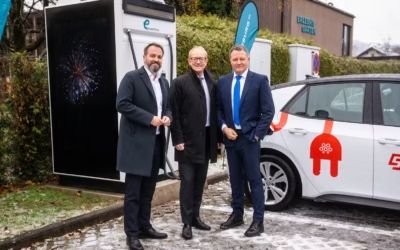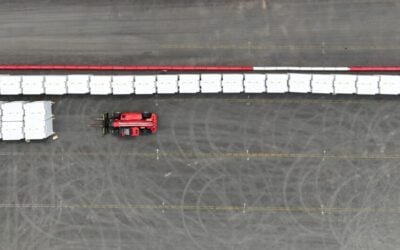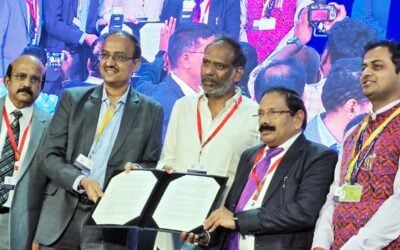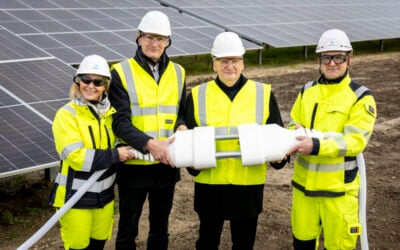Manoj Kumar Upadhyay, founder of ACME Group, talks to Energy-Storage.News in Gurgaon, New Delhi. Credit: Tom Kenning
India’s first grid-scale solar-plus-storage tender from Solar Energy Corporation of India (SECI) has received very strong interest with a total of 13 developers submitting bids.
The tender called for 5MW/2.5MWh battery enery storage systems to be added to two separate solar projects of 50MW each in the Kadapa Solar Park. A SECI document seen by Energy-Storage.News showed that the storage systems shall support the grid at rated power output for 30 minutes, with a minimum cycle life of 5,000 cycles and a response time of no more than one second.
Manoj Kumar Upadhyay, founder of ACME Group, which has one of the largest installed solar capacities in India told Energy-Storage.News that SECI will soon announce five successful developers to go through the next round of reverse bidding in an e-auction, having received a “very high level of interest”.
Upadhyay said: “Right now we are at 2-3% of energy level of solar variability in the grid. As we are increasing more and more solar energy penetration in the grid we will increase the variability. If we dont start this experiment [with storage] now it will be too late for us. So it’s a very important step this government took.”
Try Premium for just $1
- Full premium access for the first month at only $1
- Converts to an annual rate after 30 days unless cancelled
- Cancel anytime during the trial period
Premium Benefits
- Expert industry analysis and interviews
- Digital access to PV Tech Power journal
- Exclusive event discounts
Or get the full Premium subscription right away
Or continue reading this article for free
Although the storage system capacities are relatively small, Upadhyay said they will play a very useful role in grid and frequency balancing.
He added: “Sometimes in the morning in India we have a lot of haze, smog. In the morning, sometimes suddenly the haze or smog goes out and suddenly you have a clear sun. Especially in the rainy season you have a cloud, you have rain, and after rain the movement really stops, suddenly you have such a clear sun, your irradiation is highest, so you are from zero to one.”
The batteries will play a key role in smoothing these sudden changes of solar generation on the grid, whether from low-to-high or vice versa.
SECI’s intentions
Upadhyay, whose ACME Cleantech Solutions participated in the tender, said that SECI wanted to test the appetite in the market and see whether developers are interested. Having seen enough attraction already, he believes SECI may even add storage to many of its future solar tenders.
As well as finding out if the technology is ready to be deployed and if investors are willing to take a risk, SECI was also looking to find out how much subsidy they will need for future tenders, as they need to get the subsidy approved before tendering usually.
Upadhyay added: “After this tender they will be able to recalibrate for the future and go back to the government to ask for that much money. Then they can scale up.”
The tender had even been put on hold last September after energy storage industry members informed SECI that the cap on tariffs was set too low.
SECI is also due to carry out a similar tender for 150-200MW of solar-plus-storage in Karnataka.
The competition
Upadhyay said there are two types of companies; those developers who only use storage to stabilise their solar parks, and those that also manufacture and develop the technology.
ACME comes in the second category having developed storage systems from cell to full-scale solutions at utility-scale as well as for building and residential purposes. The company explained 12 months ago that the time was ripe to trial solar-plus storage combinations in India. Upadhyay also described “swarm storage” where systems are put in multiple homes and energy is collected and injected back into the grid when necessary.
Referring to the tender bids, he added: “For us working out a tariff will be more comfortable than someone who has not tested the battery earlier. That little bit of additional comfort we have.”
The firm has a manufacturing facility in Uttarakhand 250km north of New Delhi. Even ACME’s offices in Gurgaon, south of Delhi, are run by a 0.5MWh storage system including its entire network. This system even served as one of the company’s pilot projects at the early stages of its storage ventures.
ACME’s storage system based at it’s Gurgaon, New Delhi, offices. Credit: ACME
Bottom to top EV’s in India
Upadhyay also explained how in Europe and the US, storage in electric vehicles started from top to bottom with early adopters usually being rich and able to afford the new technology for their own personal transportation.
However, the approach in India is bottom to top as the technology has already been commoditised and the mass transportation sector – which he calls the “last mile of connectivity” – is getting converted to electric vehicles faster than personal transportation vehicles.
Storage will playing an increasing role in India’s complex energy system. Credit: Tom Kenning
Last week, AES and Mitsubishi Corporation announced they would develop what is thought to be India’s first grid-scale energy storage array.





